Design of Tooling System and Identifying Crucial Processing Parameters for NFPC Manufacturing in Automotive Applications
Abstract
:1. Introduction
2. Materials and Design
2.1. Design of Automotive Part and Tooling
2.2. Materials
2.3. Agglomeration of Composites
2.4. Compression Molding
2.5. Mechanical Testing
3. Results and Discussion
3.1. Challenges in Design and Part Manufacturing
3.2. Mechanical Testing
4. Conclusions
Author Contributions
Funding
Conflicts of Interest
References
- Chauhan, V.; Kärki, T.; Varis, J. Review of natural fiber-reinforced engineering plastic composites, their applications in the transportation sector and processing techniques. J. Thermoplast. Compos. Mater. 2019, 0892705719889095. [Google Scholar] [CrossRef]
- Khan, T.; Bin, M.H.S.T.; Ariffin, A.H. The challenges of natural fiber in manufacturing, material selection, and technology application: A review. J. Reinf. Plast. Compos. 2018, 37, 770–779. [Google Scholar] [CrossRef]
- Rohit, K.; Dixit, S. A review—Uture aspect of natural fiber reinforced composite. Polym. Renew. Resour. 2016, 7, 43–60. [Google Scholar] [CrossRef]
- Yallew, T.B.; Kassegn, E.; Aregawi, S.; Gebresias, A. Study on effect of process parameters on tensile properties of compression molded natural fiber reinforced polymer composites. SN Appl. Sci. 2020, 2, 338. [Google Scholar] [CrossRef] [Green Version]
- Marichelvam, M.K.; Manimaran, P.; Verma, A.; Sanjay, M.R.; Siengchin, S.; Kandakodeeswaran, K.; Geetha, M. A novel palm sheath and sugarcane bagasse fiber based hybrid composites for automotive applications: An experimental approach. Polym. Compos. 2021, 42, 512–521. [Google Scholar] [CrossRef]
- Ma, L.; He, H.; Jiang, C.; Zhou, L.; Luo, Y.; Jia, D. Effect of Alkali Treatment on Structure and Mechanical Properties of Acrylonitrile-Butadiene-Styrene/Bamboo Fiber Composites. J. Macromol. Sci. Part B Phys. 2012, 51, 2232–2244. [Google Scholar] [CrossRef]
- Saidah, A.; Susilowati, S.E.; Nofendri, Y. Effect of Fiber Loading and Alkali Treatment on Rice Straw Fiber Reinforced Composite for Automotive Bumper Beam Application. Int. J. Adv. Sci. Eng. Inf. Technol. 2019, 9, 1865–1870. [Google Scholar] [CrossRef]
- Kim, T.-W.; Lee, S.-Y.; Chun, S.-J.; Doh, G.-H.; Paik, K.-H. Effect of silane coupling on the fundamental properties of wood flour reinforced polypropylene composites. J. Compos. Mater. 2011, 45, 1595–1605. [Google Scholar] [CrossRef]
- Zhao, D.; Zhou, Z. Applications of Lightweight Composites in Automotive Industries; Yang, Y., Xu, H., Yu, X., Eds.; American Chemical Society: Washington, DC, USA, 2014; pp. 143–158. [Google Scholar] [CrossRef]
- Norhidayah, M.; Hambali, A.A.; Yaakob, M.Y.B.; Zolkarnain, M.; Taufik; Saifuddin, H. A review of current development in natural fiber composites in automotive applications. Appl. Mech. Mater. 2014, 564, 3–7. [Google Scholar] [CrossRef]
- Holbery, J.; Houston, D. Natural-fiber-reinforced polymer composites in automotive applications. J. Miner. Met. Mater. Soc. 2006, 58, 80–86. [Google Scholar] [CrossRef]
- Ashori, A. Wood-plastic composites as promising green-composites for automotive industries! Bioresour. Technol. 2008, 99, 4661–4667. [Google Scholar] [CrossRef]
- Mohammed, L.; Ansari, M.N.M.; Pua, G.; Jawaid, M.; Islam, S. A Review on Natural Fiber Reinforced Polymer Composite and Its Applications. Int. J. Polym. Sci. 2015, 2015. [Google Scholar] [CrossRef] [Green Version]
- Ning, H.; Vaidya, U.; Janowski, G.M.; Husman, G. Design, manufacture and analysis of a thermoplastic composite frame structure for mass transit. Compos. Struct. 2007, 80, 105–116. [Google Scholar] [CrossRef]
- Ning, H.; Pillay, S.; Vaidya, U.K. Design and development of thermoplastic composite roof door for mass transit bus. Mater. Eng. 2009, 30, 983–991. [Google Scholar] [CrossRef]
- Ning, H.; Janowski, G.M.; Vaidya, U.K.; Husman, G. Thermoplastic sandwich structure design and manufacturing for the body panel of mass transit vehicle. Compos. Struct. 2007, 80, 82–91. [Google Scholar] [CrossRef]
- Bartus, S.D.; Vaidya, U.K.; Ulven, C.A. Design and Development of a Long Fiber Thermoplastic Bus Seat. J. Thermoplast. Compos. Mater. 2006, 19, 131–154. [Google Scholar] [CrossRef]
- Thattaiparthasarathy, K.B.; Pillay, S.; Ning, H.; Vaidya, U.K. Process simulation, design and manufacturing of a long fiber thermoplastic composite for mass transit application. Compos. Part A Appl. Sci. Manuf. 2008, 39, 1512–1521. [Google Scholar] [CrossRef]
- Rosli, M.; Jamalludin, M.R.; Khor, C.Y.; Ishak, M.I.; Jahidi, H.; Wasir, N.Y.; Faizal, W.M.; Draman, W.N.A.W.; Lailina, N.; Ismail, R.I. Analytical Hierarchy Process for Natural Fiber Composites Automotive Armrest Thermoset Matrix Selection. In MATEC Web of Conferences; EDP Sciences: Paris, France, 2017. [Google Scholar] [CrossRef] [Green Version]
- Pervaiz, M.; Sain, M.M. Sheet-Molded Polyolefin Natural Fiber Composites for Automotive Applications. Macromol. Mater. Eng. 2003, 288, 553–557. [Google Scholar] [CrossRef]
- Paiva, A.F.; Camara, J.J. Alternative composite material for replacement of fiberglass laminates used in the manufacture of car body vehicle prototypes. SAE Tech. Pap. 2011. [Google Scholar] [CrossRef]
- Alves, C.; Ferrão, P.; Silva, A.; Reis, L.; Freitas, M.; Rodrigues, L.; Alves, D. Ecodesign of automotive components making use of natural jute fiber composites. J. Clean. Prod. 2010, 18, 313–327. [Google Scholar] [CrossRef]
- Mansor, M.; Sapuan, S.; Zainudin, E.; Nuraini, A.; Hambali, A. Hybrid natural and glass fibers reinforced polymer composites material selection using Analytical Hierarchy Process for automotive brake lever design. Mater. Des. 2013, 51, 484–492. [Google Scholar] [CrossRef]
- Dahlke, B.; Larbig, H.; Scherzer, H.D.; Poltrock, R. Natural Fiber Reinforced Foams Based on Renewable Resources for Automotive Interior Applications. J. Cell. Plast. 1998, 34, 361–379. [Google Scholar] [CrossRef]
- Nayak, S.; Khuntia, S.K.; Mohanty, S.D.; Mohapatra, J. Investigation and Fabrication of Thermo-mechanical Properties of Ceiba Pentandra Bark Fiber/Poly (Vinyl) Alcohol Composites for Automobile Dash Board and Door Panel Applications. J. Nat. Fibers 2020, 1–13. [Google Scholar] [CrossRef]
- Aly, N.M. A review on utilization of textile composites in transportation towards sustainability. In IOP Conference Series: Materials Science and Engineering; IOP Publishing: Bristol, UK, 2017. [Google Scholar]
- Singha, A.S.; Rana, R.K. Natural fiber reinforced polystyrene composites: Effect of fiber loading, fiber dimensions and surface modification on mechanical properties. Mater. Des. 2012, 41, 289–297. [Google Scholar] [CrossRef]
- Liu, W.; Drzal, L.T.; Mohanty, A.K.; Misra, M. Influence of processing methods and fiber length on physical properties of kenaf fiber reinforced soy based biocomposites. Compos. Part B Eng. 2007, 38, 352–359. [Google Scholar] [CrossRef]
- Bledzki, A.K.; Faruk, O. Wood Fiber Reinforced Polypropylene Composites: Compression and Injection Molding Process. Polym. Plast. Technol. Eng. 2004, 43, 871–888. [Google Scholar] [CrossRef]
- Singha, A.S.; Thakur, V.K. Mechanical properties of natural fibre reinforced polymer composites. Bull. Mater. Sci. 2008, 31, 791–799. [Google Scholar] [CrossRef]
- Singha, A.S.; Thakur, V.K. Saccaharum Cilliare Fiber Reinforced Polymer Composites. E J. Chem. 2008, 5, 782–791. [Google Scholar] [CrossRef]
- Zampaloni, M.; Pourboghrat, F.; Yankovich, S.; Rodgers, B.; Moore, J.; Drzal, L.; Mohanty, A.; Misra, M. Kenaf natural fiber reinforced polypropylene composites: A discussion on manufacturing problems and solutions. Compos. Part A Appl. Sci. Manuf. 2007, 38, 1569–1580. [Google Scholar] [CrossRef]
- Takemura, K.; Minekage, Y. Effect of molding condition on tensile properties of hemp fiber reinforced composite. Adv. Compos. Mater. 2007, 16, 385–394. [Google Scholar] [CrossRef]
- Lokesh, P.; Surya Kumari, T.S.A.; Gopi, R.; Loganathan, G.B. A study on mechanical properties of bamboo fiber reinforced polymer composite. Mater. Today Proc. 2020, 22, 897–903. [Google Scholar] [CrossRef]
- Ameri, E.; Laperrière, L.; Lebrun, G. Mechanical characterization and optimization of a new unidirectional flax/paper/epoxy composite. Compos. Part B Eng. 2016, 97, 282–291. [Google Scholar] [CrossRef]
- Sapuan, S.M. Composite Materials: Concurrent Engineering Approach; Butterworth-Heinemann: Boston, MA, USA, 2017; pp. 57–93. [Google Scholar]
- Kalpakjian, S.; Schmid, S.R. Plastics and Composite Materials: Forming and Shaping. In Manufacturing Engineering and Technology, 6th ed.; Kalpakjian, S., Schmid, S.R., Eds.; Prentice Hall: Singapore, 2010; pp. 484–524. [Google Scholar]
- Jaafar, J.; Siregar, J.P.; Tezara, C.; Hamdan, M.H.M.; Rihayat, T. A review of important considerations in the compression molding process of short natural fiber composites. Int. J. Adv. Manuf. Technol. 2019, 105, 3437–3450. [Google Scholar] [CrossRef]
- Saravanan, K.; Dhurai, B. Effect of process parameters on impact strength of short jute fibre reinforced polypropylene composite board. Indian J. Fibre Text Res. 2013, 38, 92–95. [Google Scholar]
- Tungjitpornkull, S.; Sombatsompop, N. Processing technique and fiber orientation angle affecting the mechanical properties of E-glass fiber reinforced wood/PVC composites. J. Mater. Process. Technol. 2009, 209, 3079–3088. [Google Scholar] [CrossRef]
- Elamri, A.; Abid, K.; Harzallah, O.; Lallam, A. Characterization of Recycled/Virgin PET Polymers and their Composites. Am. J. Nano Res. Appl. 2015, 3, 11–16. [Google Scholar] [CrossRef]
- Park, C.H.; Lee, W.I. Compression molding in polymer matrix composites. In Manufacturing Techniques for Polymer Matrix Composites (PMCs); Elsevier: Amsterdam, The Netherlands, 2012; pp. 47–94. [Google Scholar] [CrossRef]
- Syahirah, S.; Hazwani, N.; Faizin, A.; Farhan, M. Design and Development of Heating Press System for Compression Molding Part 2; Faculty of Mechanical Engineering, Universiti Malaysia Pahang: Pahang, Malaysia, 2016. [Google Scholar]
- Barone, J.R.; Schmidt, W.F.; Liebner, C.F.E. Compounding and molding of polyethylene composites reinforced with keratin feather fiber. Compos. Sci. Technol. 2005, 65, 683–692. [Google Scholar] [CrossRef]
- Kumar, A.; Srivastava, A. Preparation and Mechanical Properties of Jute Fiber Reinforced Epoxy Composites. Ind. Eng. Manag. 2017, 6. [Google Scholar] [CrossRef]
- Vijay, R.; Singaravelu, D.L. Experimental investigation on the mechanical properties of Cyperus pangorei fibers and jute fiber-based natural fiber composites. Int. J. Polym. Anal. Charact. 2016, 21, 617–627. [Google Scholar] [CrossRef]
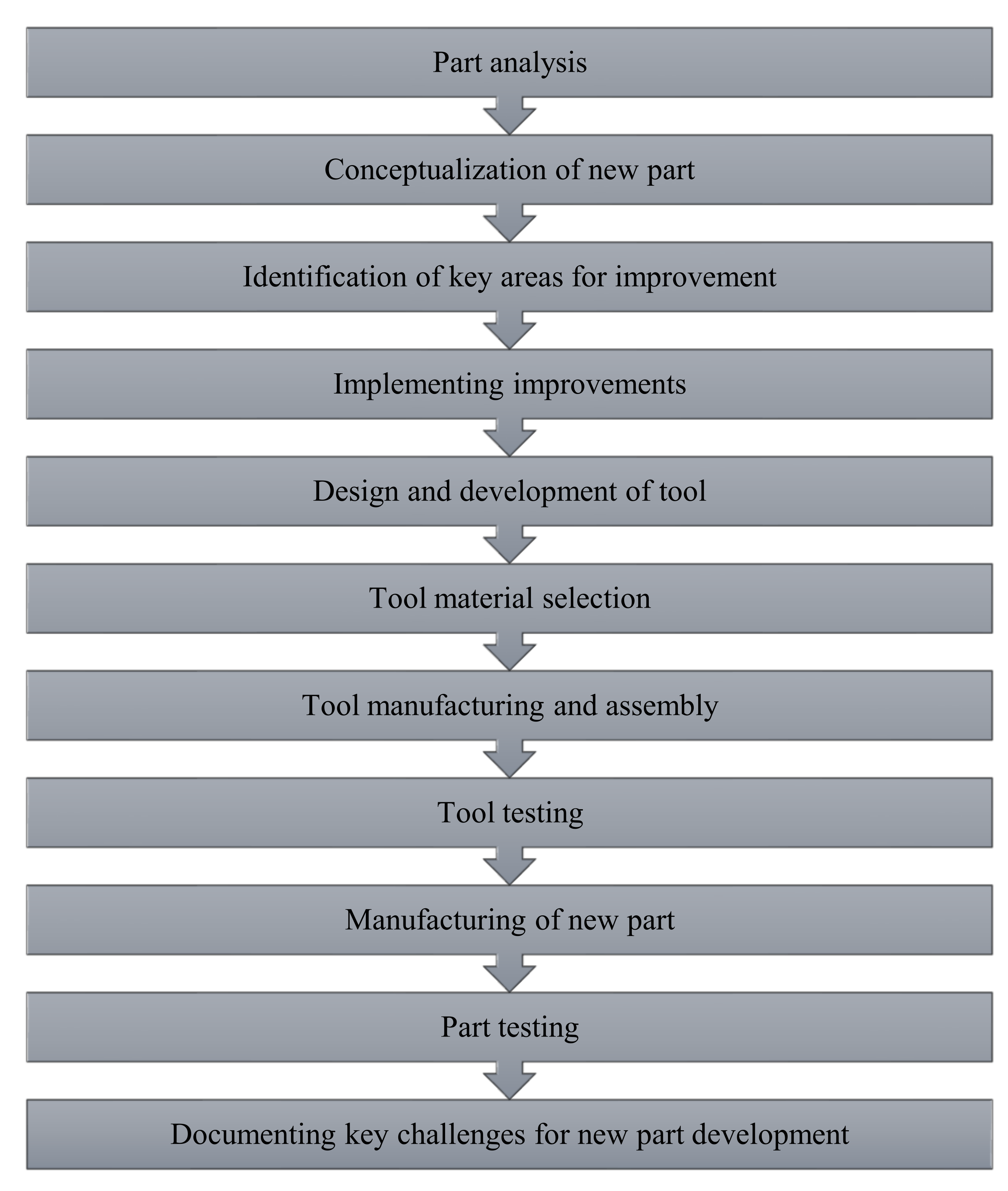





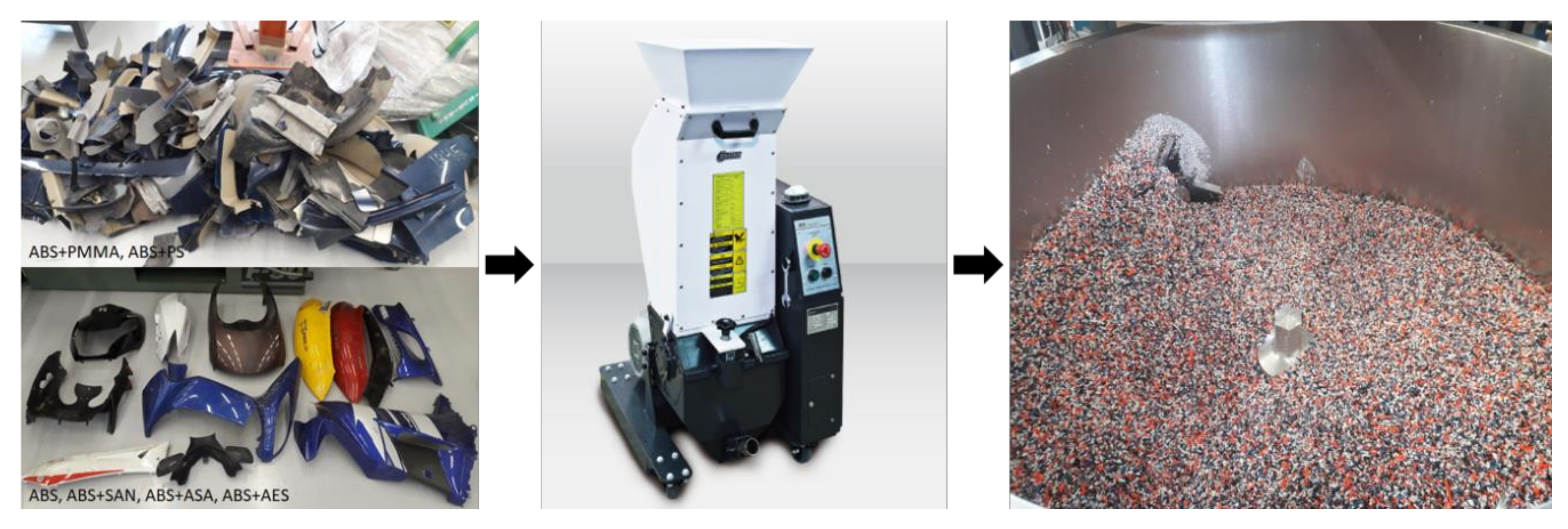
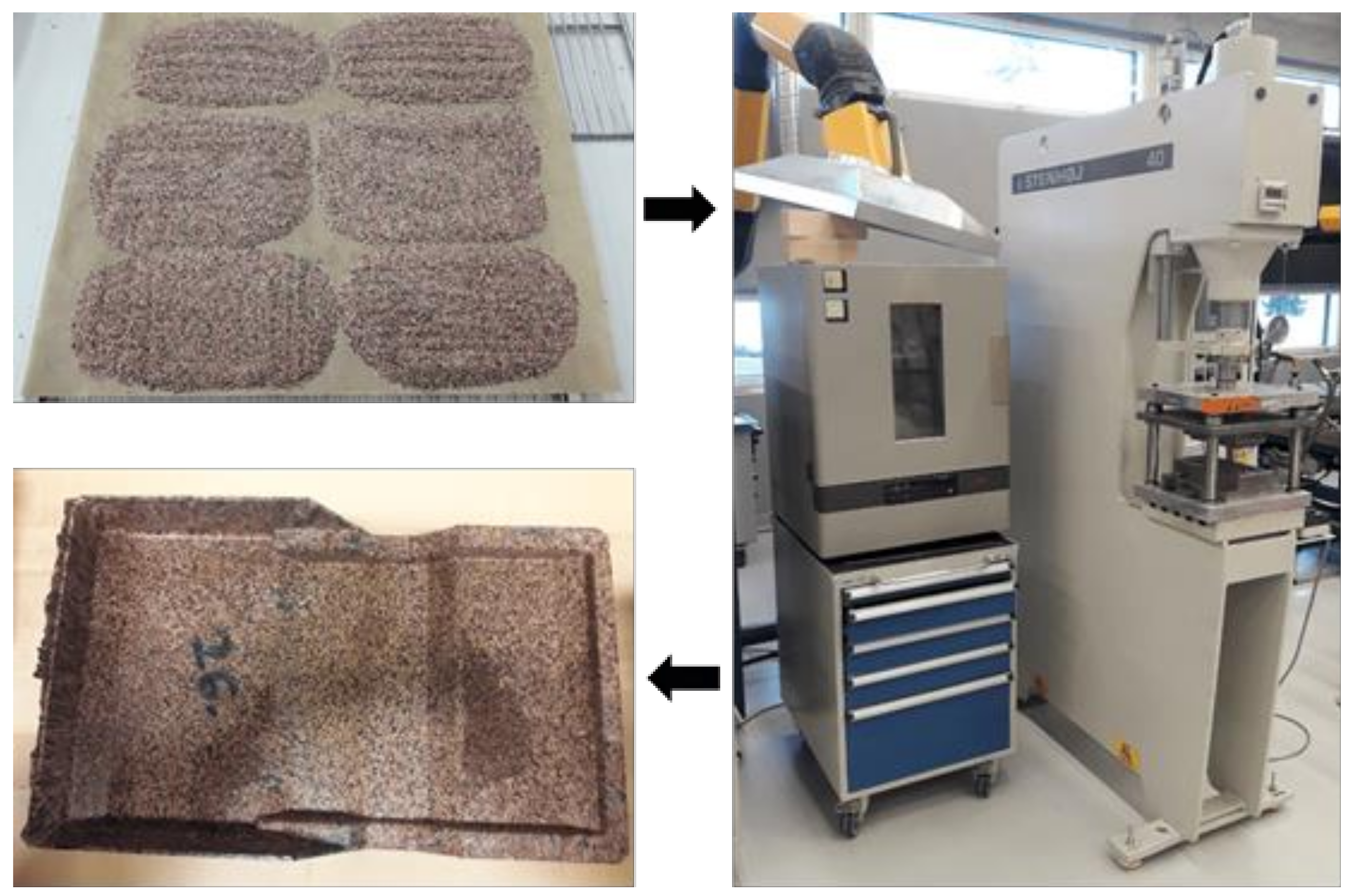




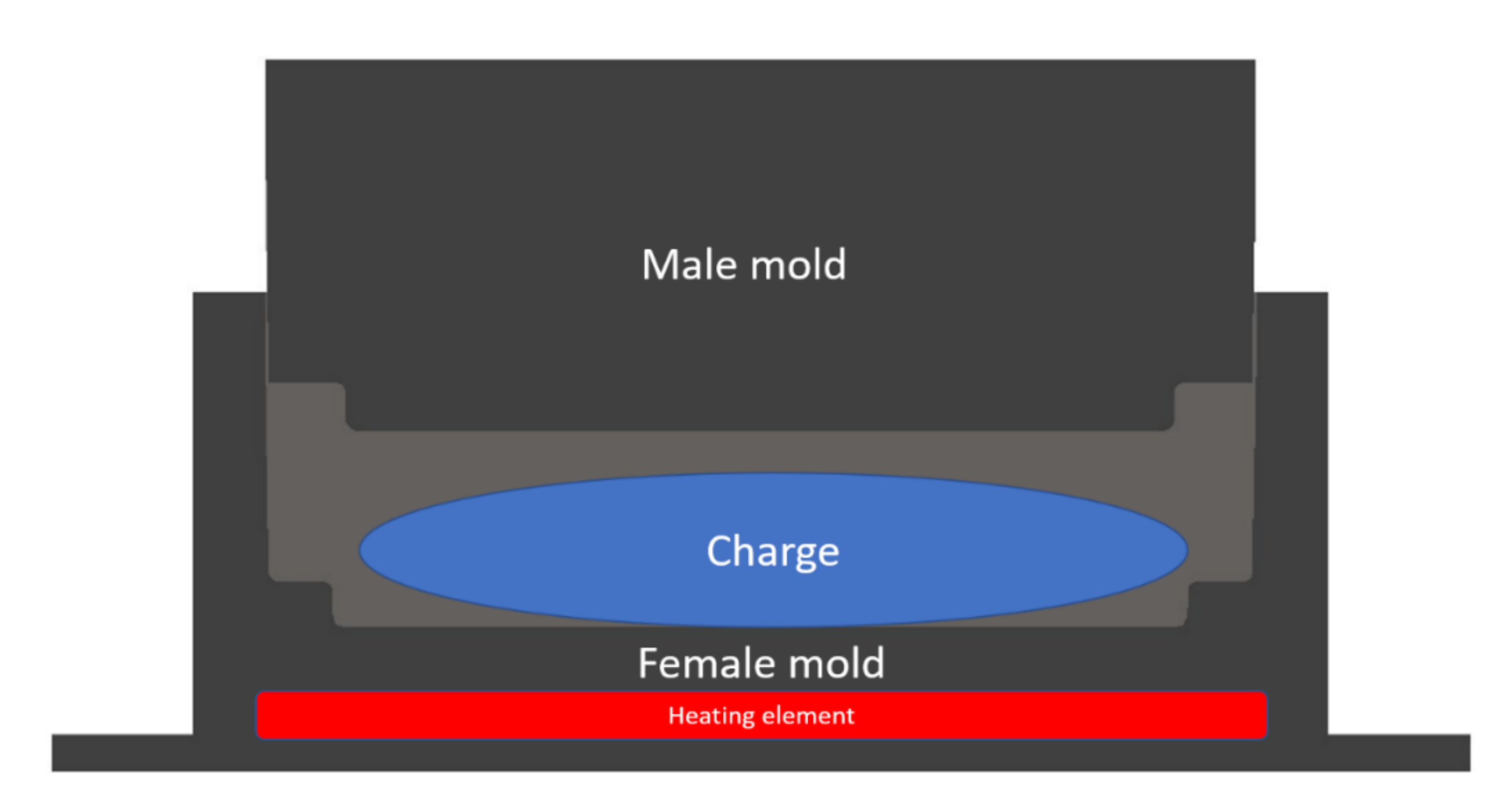

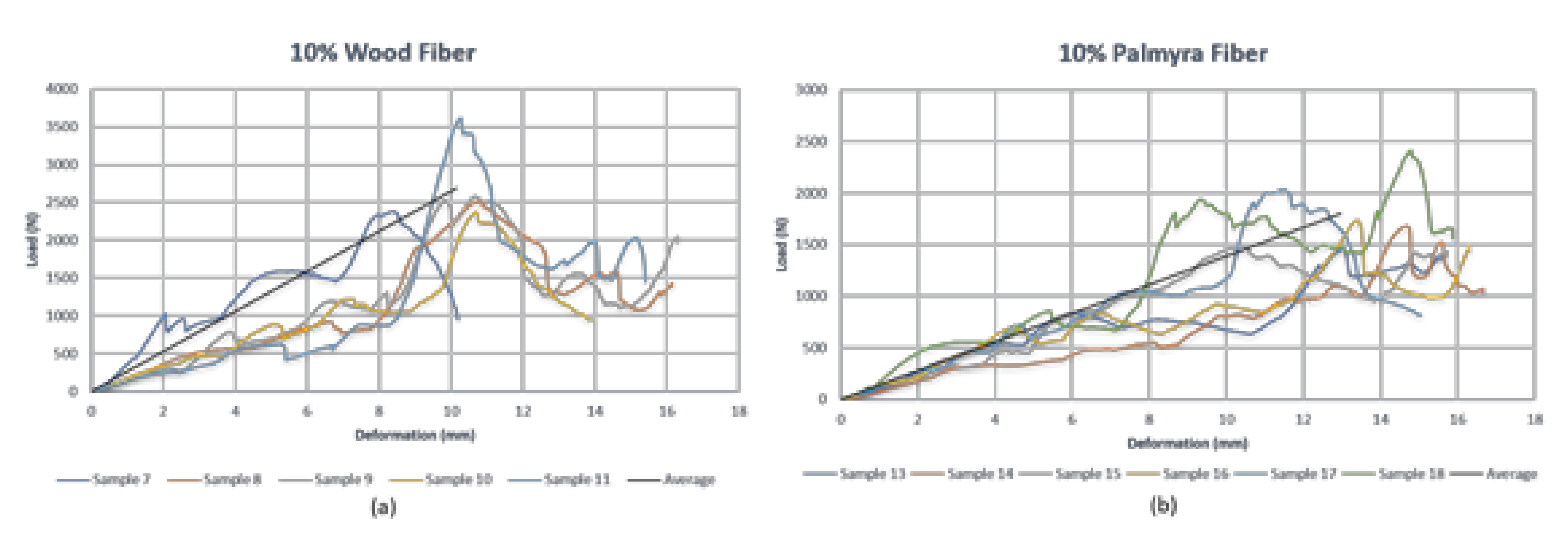
| Material | Design | Process |
|---|---|---|
| Fiber % | Height of the part | Compression time |
| Polymer % | Radius of edges | Pressure |
| Density | Thickness of part | Mold temperature |
| Melt flow index | Tool clearance | Material temperature |
| Additives | Draft angle | Material heating time |
| Blend | Polymer | Fiber | Polymer (%) | Fiber (%) | Lubricant (%) | Plasticizer (%) |
|---|---|---|---|---|---|---|
| Blend 1 | R-ABSmix | - | 92 | - | 3 | 5 |
| Blend 2 | R-ABSmix | Wood | 82 | 10 | 3 | 5 |
| Blend 3 | R-ABSmix | Palmyra | 82 | 10 | 3 | 5 |
| Blend | Material Wt (gms) | Oven Temp (°C) | Material Temp (°C) | Heating Time (mins) | Female Tool Temp (°C) | Male Tool Temp (°C) | Compression Time (s) | Pressure (kN) * |
|---|---|---|---|---|---|---|---|---|
| Blend 1 | 400 | 260 | 205 | 15 | 71.5 | 62 | 120 | 392 |
| Blend 2 | 400 | 260 | 204 | 15 | 68.5 | 60 | 120 | 392 |
| Blend 3 | 400 | 260 | 202 | 15 | 70.5 | 63 | 120 | 395 |
| Elastic Modulus (MPa) | Load (N) | Deformation (mm) | |
|---|---|---|---|
| Blend 1 | 1568.68 | 1692.70 | 14.45 |
| Blend 2 | 3156.43 s | 2690.36 s | 10.15 s |
| Blend 3 | 2032.95 ns | 1802.66 ns | 12.97 ns |
Publisher’s Note: MDPI stays neutral with regard to jurisdictional claims in published maps and institutional affiliations. |
© 2021 by the authors. Licensee MDPI, Basel, Switzerland. This article is an open access article distributed under the terms and conditions of the Creative Commons Attribution (CC BY) license (https://creativecommons.org/licenses/by/4.0/).
Share and Cite
Chauhan, V.; Kärki, T.; Varis, J. Design of Tooling System and Identifying Crucial Processing Parameters for NFPC Manufacturing in Automotive Applications. J. Compos. Sci. 2021, 5, 169. https://doi.org/10.3390/jcs5070169
Chauhan V, Kärki T, Varis J. Design of Tooling System and Identifying Crucial Processing Parameters for NFPC Manufacturing in Automotive Applications. Journal of Composites Science. 2021; 5(7):169. https://doi.org/10.3390/jcs5070169
Chicago/Turabian StyleChauhan, Vardaan, Timo Kärki, and Juha Varis. 2021. "Design of Tooling System and Identifying Crucial Processing Parameters for NFPC Manufacturing in Automotive Applications" Journal of Composites Science 5, no. 7: 169. https://doi.org/10.3390/jcs5070169
APA StyleChauhan, V., Kärki, T., & Varis, J. (2021). Design of Tooling System and Identifying Crucial Processing Parameters for NFPC Manufacturing in Automotive Applications. Journal of Composites Science, 5(7), 169. https://doi.org/10.3390/jcs5070169






